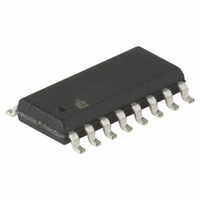X9420YS16I Intersil, X9420YS16I Datasheet - Page 4

X9420YS16I
Manufacturer Part Number
X9420YS16I
Description
IC XDCP SGL 64-TAP 2.5K 16-SOIC
Manufacturer
Intersil
Series
XDCP™r
Datasheet
1.X9420WV14I-2.7.pdf
(19 pages)
Specifications of X9420YS16I
Taps
64
Resistance (ohms)
2.5K
Number Of Circuits
1
Temperature Coefficient
300 ppm/°C Typical
Memory Type
Non-Volatile
Interface
SPI, 3-Wire Serial
Voltage - Supply
4.5 V ~ 5.5 V
Operating Temperature
-40°C ~ 85°C
Mounting Type
Surface Mount
Package / Case
16-SOIC (0.300", 7.5mm Width)
Resistance In Ohms
2.5K
Number Of Elements
1
# Of Taps
64
Resistance (max)
2.5KOhm
Power Supply Requirement
Dual
Interface Type
Serial (SPI)
Single Supply Voltage (typ)
Not RequiredV
Dual Supply Voltage (typ)
±5V
Single Supply Voltage (min)
Not RequiredV
Single Supply Voltage (max)
Not RequiredV
Dual Supply Voltage (min)
±4.5V
Dual Supply Voltage (max)
±5.5V
Operating Temp Range
-40C to 85C
Operating Temperature Classification
Industrial
Mounting
Surface Mount
Pin Count
16
Package Type
SOIC W
Lead Free Status / RoHS Status
Contains lead / RoHS non-compliant
PIN NAMES
PRINCIPLES OF OPERATION
The X9420 is a highly integrated microcircuit
incorporating a resistor array and associated registers
and counter and the serial interface logic providing
direct communication between the host and the XDCP
potentiometer.
Serial Interface
The X9420 supports the SPI interface hardware
conventions. The device is accessed via the SI input
with data clocked in on the rising SCK. CS must be
LOW and the HOLD and WP pins must be HIGH
during the entire operation.
The SO and SI pins can be connected together, since
they have three state outputs. This can help to reduce
system pin count.
Array Description
The X9420 is comprised of one resistor array
containing 63 discrete resistive segments that are
connected in series. The physical ends of each array
are equivalent to the fixed terminals of a mechanical
potentiometer (V
At both ends of the array and between each resistor
segment is a CMOS switch connected to the wiper
(V
switch may be turned on at a time.
These switches are controlled by a Wiper Counter
Register (WCR). The six bits of the WCR are decoded to
select, and enable, one of sixty-four switches. The block
diagram of the potentiometer is shown in Figure 1.
W
Symbol
V
V
SI, SO
HOLD
V
V+,V-
/R
SCK
W
H
V
V
WP
NC
L
A0
/R
CC
SS
/R
/R
W
H
L
W
) output. Within the individual array only one
,
Serial Clock
Serial Data
Device Address
Potentiometer Pins (terminal equivalent)
Potentiometer Pins (wiper equivalent)
Hardware Write Protection
Serial Communication Pause
Analog Supplies
System Supply Voltage
System Ground
No Connection
H
/R
H
and V
4
Description
L
/R
L
inputs).
X9420
Wiper Counter Register (WCR)
The X9420 contains a Wiper Counter Register. The
WCR can be envisioned as a 6-bit parallel and serial
load counter with its outputs decoded to select one of
sixty-four switches along its resistor array. The
contents of the WCR can be altered in four ways: it
may be written directly by the host via the Write Wiper
Counter Register instruction (serial load); it may be
written indirectly by transferring the contents of one of
four associated data registers via the XFR Data
Register instruction (parallel load); it can be modified
one step at a time by the Increment/ Decrement
instruction. Finally, it is loaded with the contents of its
data register zero (DR0) upon power-up.
The Wiper Counter Register is a volatile register; that
is, its contents are lost when the X9420 is powered-
down. Although the register is automatically loaded
with the value in DR0 upon power-up, this may be
different from the value present at power-down.
Data Registers
The potentiometer has four 6-bit nonvolatile Data
Registers. These can be read or written directly by the
host. Data can also be transferred between any of the
four Data Registers and the WCR. It should be noted all
operations changing data in one of the Data Registers is
a nonvolatile operation and will take a maximum of 10ms.
If the application does not require storage of multiple
settings for the potentiometer, the Data Registers can
be used as regular memory locations for system
parameters or user preference data.
Register Descriptions
Table 1. Data Registers, (6-bit), Nonvolatile
There are four 6-bit Data Registers associated with the
potentiometer.
– {D5~D0}: These bits are for general purpose Non-
Table 2. Wiper Counter Register, (6-bit), Volatile
– {WP5~WP0}: These bits specify the wiper position
(MSB)
(MSB)
volatile data storage or for storage of up to four dif-
ferent wiper values.
of the potentiometer.
0
0
0
0
WP5 WP4 WP3 WP2 WP1 WP0
D5
D4
D3
D2
D1
April 26, 2006
(LSB)
(LSB)
FN8195.1
D0












